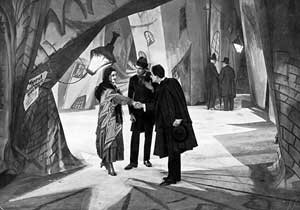In this post I set out to investigate the meaning of mis en scene and montage. Mis en scene is french phrase that literally means ‘putting on stage’. Basically in film mis-en-scene is the arrangement of everything that appears in the framing. Including actors, lighting, decor, props and costume. The nature of the frame itself and the camera work is also considered apart of mis-en-scene. Its how the director chooses to what goes where and when within a frame. It’s important to note that mis-en-scene is made up of elements that appear within the shot itself, not the effects created by cutting these shots together like montage.
Mis en scene is collaborated effort between set designers, lighting crew, costume, makeup, location scouts but ultimately the director overseas the entire mis-en-scene and all of its elements. Sometimes mis en scene can evoke emotions the set up precedence for the entire film. In Histories of Film Theory we watched the German expressionist film The Cabinet of Dr. Caligari (1920) which features distorted shapes and confined scenery to disturb the audience.

In france montage simply denotes cutting. At a basic level its the relationship between shots. So the process of cutting of film and editing it into a sequence. Montage can provide alot of information in a short period of time. When I think of montage I think of a juxtaposition of short shots to represent action or ideas. Theorist Sergei Eisenstein believed that film montage could create ideas and have an impact beyond the individual images. A couple of weeks ago I watched Eisenstein’s Battleship Potemkim which was a great demonstration of the power of montage, as he manipulates the audiences perception of time by stretching out the Odessa stair sequence making it longer than it would take in real life. The quick progression of images gives the impressive event even more visual impact. This film also represents ideological potential of montage as it is a call to the people to rise up against oppression.
So Mis-en-scene is the arrangement of everything that appears in the framing and montage at its most basic level is the relationship between these shots. Montage and Decoupage seem to be quite similar concepts that could easily be confused with each other. Decoupage generally seems to apply a single space whereas can also apply to multiple spaces aka. parallel montage. Furthermore , decoupage is about pre production for instance the script with all the technical information for instance the mis-en-scene, camera placement, actor position etc. Whereas montage seems to be associated more with the post production and the editing cuts themselves. Montage is more of an editing style whereas decoupage is the underlying structure of the entire film. Decoupage is the process of how the film is mapped out to establish spatial relations. However from my understanding montage tends to be more about temporal relations between shots.